The Chuwi LapBook 14.1 Review: Redefining Affordable
by Brett Howse on March 10, 2017 8:00 AM ESTSystem Performance
With the preamble out of the way, let’s dig into just how this new Apollo Lake platform does perform. The Chuwi LapBook 14.1 features the Intel Celeron N3450, which is a quad-core CPU, which runs between 1.1 GHz and 2.2 GHz. There is no Hyperthreading available. There is 4 GB of memory, and Intel HD graphics 500, which is Gen 9 graphics with 12 execution units. The GPU runs between 200 MHz and 700 Mhz. With a 6 W TDP, and 4 W SDP, there is no fan required.
To measure performance, the LapBook was run through our typical set of tests, and for comparison several other devices were selected to get a good representation of where the LapBook fits in. The HP Stream 11 is the Celeron N2840, which is a dual-core Bay Trail-M offering, and when it was tested it was $199. The 2017 model is still a dual-core, but Braswell based with the N3050, so the LapBook should have a big advantage with twice as many cores.
We don’t get a lot of less expensive devices, so we’ll also see the ASUS UX305, which features a Broadwell based Core M 5Y10, and Lenovo Yoga 3 Pro with Core M 5Y71, for comparison to a slightly older 4.5-Watt Core M part. Also, the Microsoft Surface 3 features the fastest Cherry Trail Atom x7 available at that time, which is a quad-core Airmont part, but with a 2-Watt SDP. The Razer Blade Stealth is a thin and light 15-Watt Core product, and although it’s quite a bit more expensive, it’s a good comparison for a modern Ultrabook performance versus the latest Atom. Finally, I’ve selected the Acer Aspire S3, which is an older Core i7-2637M processor, to see how the latest Atom fares against older Core, and the Acer Aspire S7 with Haswell Core i7-4500U. Clearly, the HP Stream 11 will be the most relevant comparison, but since we get so few of these low-end devices in, it will be good to see where they fit, especially if you are thinking of replacing an older notebook. We don’t have full results for some of the older devices, since testing methodology changes over the years, but if you’d like to compare the Chuwi LapBook 14.1 against any other device we’ve tested, please check out our online Bench.
PCMark
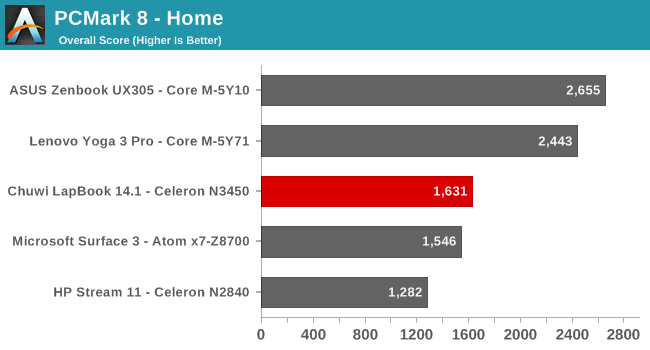
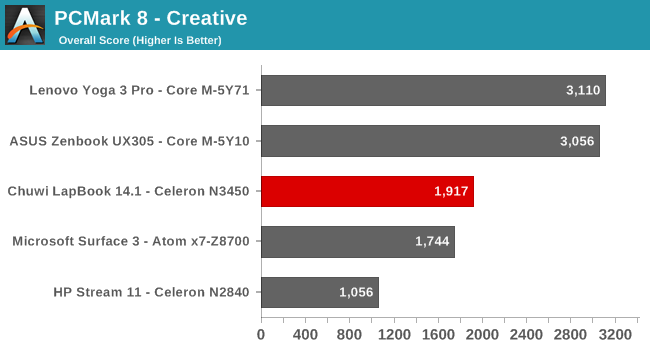
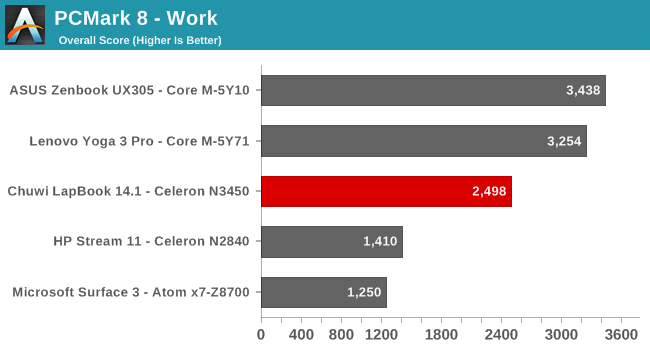

PCMark is an all-in-one benchmark, which tests all aspects of a system, including CPU, GPU, and storage. It tries to use real-world tests, which will stress burst performance by the processor, as well as some more demanding longer duration tests. The new Goldmont cores, paired with Gen 9 graphics, have certainly moved the bar forward for Atom. The performance is quite a bit better than the HP Stream, although that is just a dual core device, but it’s also well ahead of the Microsoft Surface 3, which has a quad-core Cherry Trail X7-Z8700, but with a 2-Watt SDP compared to the 4-Watt SDP in the Apollo Lake. But even if you compare it to the Lenovo Yoga 3 Pro, with Core M-5Y71, the Chuwi offers about 70% of the performance of this in PCMark 8. Granted the Yoga 3 Pro was not the most performant Core M system, but still, it’s a decent result, when you consider the Chuwi costs about 25% of that device.
Cinebench
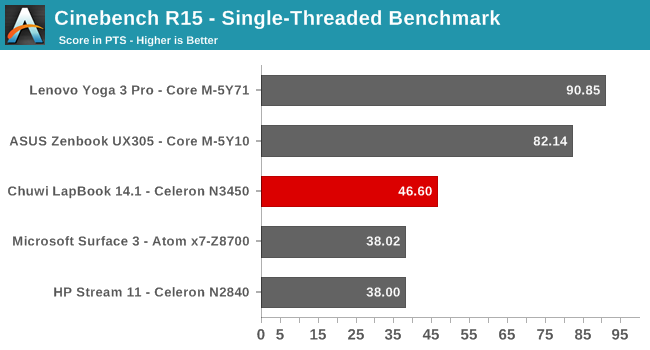
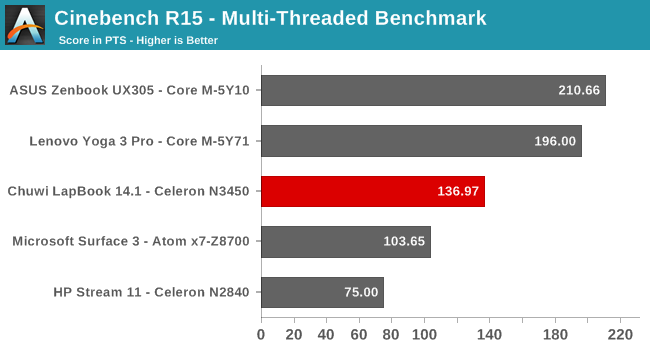
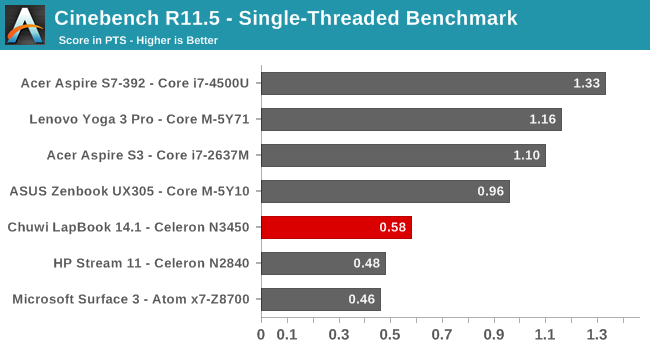
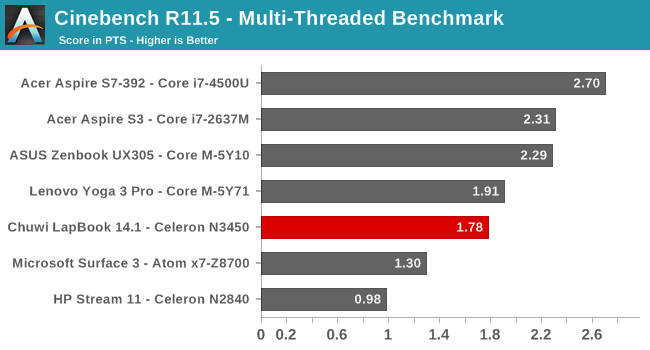
Cinebench is a pure CPU test, with higher performance cores, and multiple cores, giving much more performance. Here we can see the jump in single-threaded performance from the HP Stream 11 with it’s Bay Trail-M Silvermont cores, and the Chuwi LapBook with it’s Goldmont cores. Of course, the jump is even higher on the multi-threaded tests, since the Chuwi has a quad-core CPU rather than the dual-core in the HP Stream 11. It’s tougher to get a proper picture compared to the Airmont powered Surface 3, since that tablet SoC has half the scenario design power, but, the performance over the X7-Z8700 is significant. Once again, the Core M powered devices walk away from Atom here, as do the older higher TDP Core i7 in the two Acer models.
x264

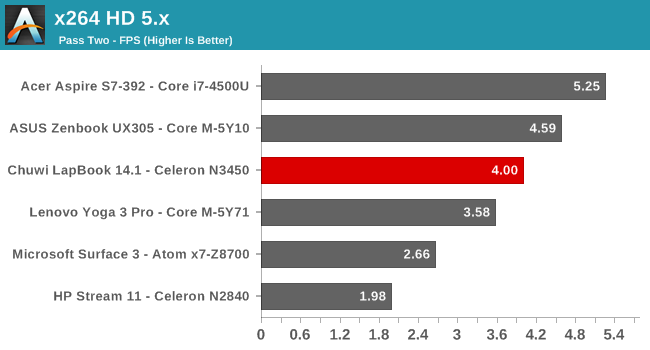
Much like Cinebench, x264 encodes a movie using the CPU, so this is a pure CPU test. The results are also much the same as Cinebench, but it’s interesting to note the Chuwi LapBook has passed the Core M powered Lenovo Yoga 3 Pro on pass two. The Yoga 3 Pro had some serious thermal issues, and Lenovo chose to limit the CPU temperature despite having a fan in the device, but it’s still impressive to see a Goldmont CPU perform better than a Broadwell CPU. Here the Chuwi LapBook scores 87% of the ASUS UX305, which was a solid performing Core M machine, despite it having the slowest Core M available in the Broadwell era.
Web Results
Testing the web performance is important because it’s arguably the most-used application on any PC. It’s worth pointing out again that all of our web performance testing prior to Windows 10 was done on Google Chrome, and the browser can have a more significant impact on the overall score than the CPU. When Microsoft Edge came along, offering performance that equalled or passed Chrome, we made the switch back to the stock browser. The exception here is the Acer Aspire S7-392, which was tested with Internet Explorer. Take these scores with that knowledge.
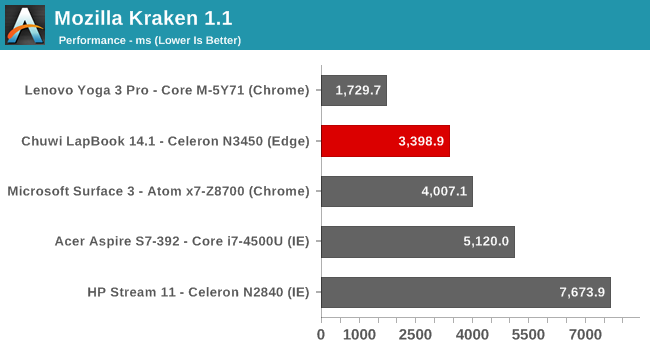
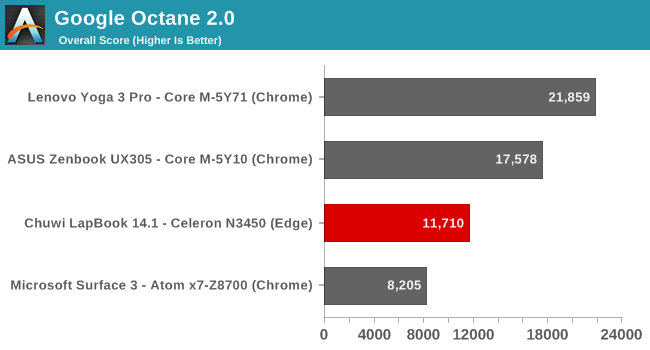

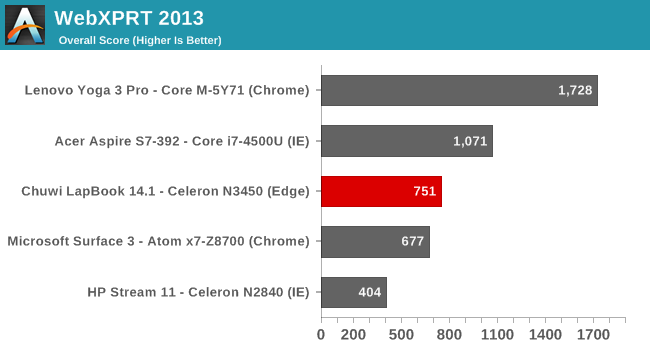
In all the tests, the Chuwi outperforms the Microsoft Surface 3’s Atom CPU, and is much quicker than the HP Stream 11, even with the browser differences. It can’t compete here with Core M, especially the Yoga 3 Pro which has the highest boost frequency, but compared to older Atom devices, it’s a nice step forward.
CPU Conclusion
It remains to be seen what will happen to Atom going forward, but for now, we can take a look at the latest Intel Apollo Lake platform with a quad-core Goldmont CPU. The step forward with Goldmont is significant, which bodes well for the platform, but it’s difficult to say if this will be enough with increased competition coming in the near future. Day to day use of the Chuwi LapBook was typical of any Atom powered device, in that it feels a bit slower than I’m used to, but the experience is not terrible. The fact that it provides about 70% of the performance in PCMark 8, compared to the Yoga 3 Pro, is quite remarkable, for a device that costs less than 25%. This would be difficult to use as a main computer for anyone, but if you need a portable computer on the cheap, the performance is not too bad.










75 Comments
View All Comments
BrokenCrayons - Friday, March 10, 2017 - link
Chuwi hits all the right specifications for RAM and storage space that I'd like to see in a budget laptop and being fanless is nice too. I'd actually prefer a 11.6 inch screen and a 1366x768 screen because, for a small and cheap portable, 14 inches is actually more than I'd need and I'd rather push fewer pixels with the relatively weak GPU. Some of the touchpad and heat concerned expressed in the Amazon review section are a bit off-putting as well and I don't like an all white system. I just with HP would offer up a 64GB version of their Stream 11. If they did, I'd be falling all over myself to buy one.DanNeely - Friday, March 10, 2017 - link
According to what I found the really cheap windows license comes with a 32GB SSD requirement from MS. Assuming that's still the case 64GB would require HP to charge nearly $100 more for $10 of hardware, Chuwi is probably cheating MS to hit this price with 64GB.http://www.cnx-software.com/2016/09/02/hardware-re...
Bullwinkle J Moose - Friday, March 10, 2017 - link
Doubtful that 32GB is really an MS requirement but more likely the minimum recommended size for a boot driveI've restored Win 8.1 32-bit to 16GB and 64-bit 8.1 to 20GB boot partitions before
32GB is likely the smallest SSD boot drive you will see in actual use
If I had problems booting Windows from the internal M.2 slot, I would run Windows to Go from the USB3 port which is fast enough for this class of processor and can then easily switch to a Linux thumb drive whenever I like
A 256GB Corsair GTX thumb drive would boot Windows a hell of a lot faster than that internal 64GB eMMC drive anyway and provides better security for my data
For example, anyone stealing the laptop would have an empty internal drive while my data remains safe in my pocket until the insurance replaces the hardware
DanNeely - Saturday, March 11, 2017 - link
I'm pretty sure it's legit. That was just the 1st cite I found, but matches what I've seen a few other places since W10 launched. MS has offered heavily discounted windows installs to low end computers since the initial linux based netbooks appeared almost a decade ago. In one way or another they've always limited it to the lowest tier of systems. The fact that mainstream makers either don't offer 64GB varients or charge prices significantly above the cost of the extra flash (eg the HP stream is $200 vs 260 on Amazon) is strongly suggestive that its where they're currently setting the cutoff.32GB is restrictive enough (to the extent of causing problems with major win10 updates) that I wish MS would raise the limit to 64GB; but I haven't seen any evidence that they have. Other than that, the numbers are IMO reasonable for the netbook class system that have always been the targets of the program.
dragosmp - Friday, March 10, 2017 - link
Would you test the Asus 402 and 403 ? In a similar sort of vein, they're apparently marketed as "premium budget notebooks" and go for 250-350$. The difference is the 403 is 1080p and the 402 is 768p.I think this category has some potential. If I found a 4GB/1080p e403 in the UK I'd buy one now.
crimson117 - Friday, March 10, 2017 - link
I'm really hoping this laptop makes a Chewbacca sound when you open the lid.andychow - Friday, March 10, 2017 - link
In the registry, change the ExcludeFromCPL value for windowslogon to get the option in the sound panel, or just replace the windows logon .wav file directly.pattycake0147 - Friday, March 10, 2017 - link
Or provide you with some chewy granola bars in the box.wolfemane - Friday, March 10, 2017 - link
Nice! Very cool to see a review of this cool little device!!! I got one of these for my wife this past Christmas. Was on a flash sale @ Newegg for $200 and she really wanted a super cheap 2 in 1 type system that supported micro sd. Before recovering it I had 0 faith in the product at that price and really thought a far more expensive known brand would be better for what she was going to use it for. Boy was I wrong. Other than our main computers it's the single most used device in the house. A bit heavy, but works far better than I would have ever expected of such a cheap device. Color accuracy of the screen is the shining aspect of this little machine. The color accuracy is so good, and the performance is good enough to do basic quick photoshop work, that my wife now uses it to give clients "sneak peaks " post photo op.coder111 - Friday, March 10, 2017 - link
How well does this run Linux?Is there a version with Linux preinstalled?